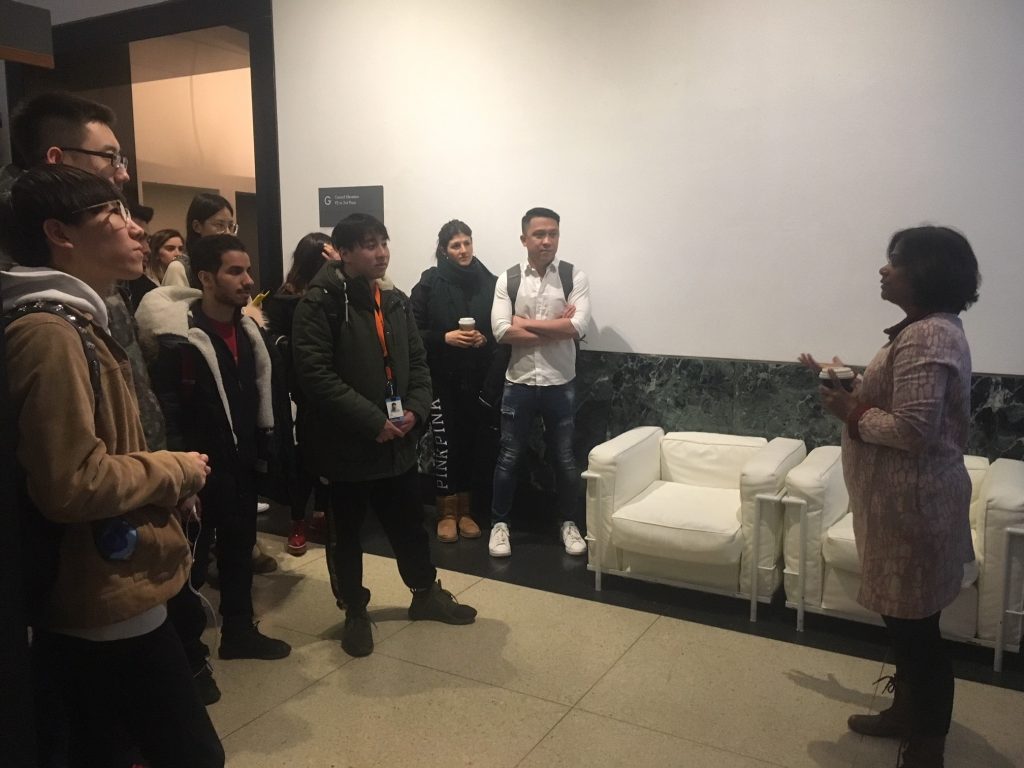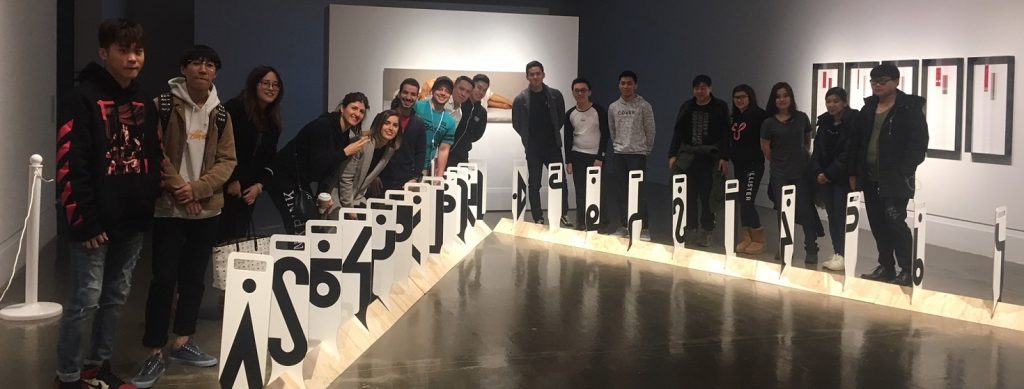Intersections: ESL at the Art Gallery of Mississauga
By: Prof. Allyson Conrad (ESL)

Students listen to an explanation by Sharada Eswar about the exhibits in the gallery. (Photo: Allyson Conrad)
As a new professor in the Faculty of Humanities and Social Sciences at Sheridan, I endeavour to meet the challenge of bringing indigenous knowledge into my classrooms and build bridges of learning that will connect students with our community. I found this particularly challenging this past semester as I began teaching ESL and many of my students, as international students, had very little understanding of the history or present condition of indigenous peoples in Canada. I have a preference for learning methods that offer students a chance to explore the topic themselves and form their own opinions. Eventually I stumbled upon the Art Gallery of Mississauga and spoke with Sherada Eswar, the Community Activator, Education and Programmes, who agreed to give a talk to the students about the art on display there so on March 26, my class of advanced students from the ESL program at HMC campus took a field trip to the gallery to explore the exhibit niigaanikwewag. We met in the morning on campus (our apologies to Starbucks) and walked to the gallery together.
Sherada was very welcoming and knowledgeable about the art on display and she explained many things to the students, leaving plenty of room for questions. The students took time to view all of the exhibits but were encouraged to particularly explore the indigenous art. One of the biggest benefits of the trip was it was completely free (donation suggested) which eased students worries (and mine) about extra costs. We were also able to view the exhibit Casting Hooks by Inuk sculptor, Couzyn van Heuvelen, whose work “Nitsiit” is currently on display in the Creativity Commons at HMC campus.
The group of students came from my advanced listening, speaking and note taking class so the talk at the art gallery fit into our learning perfectly. One of the learning goals of our class is discussing controversial issues, so I assigned students to gather information for a group discussion followed the trip. To prepare, students read historical accounts of indigenous peoples and watched films and documentaries about current issues that indigenous communities face.
In the group discussion students debated about whose responsibility it is to solve issues in indigenous societies: indigenous people’s or non-indigenous citizens of Canada? Students were graded on their use of functional language taught in class, grammar, clarity and amount of preparation/research displayed. The discussions were well researched and showed great insight into the topic. Many students expressed that their home countries had indigenous peoples too and some of the discussions became quite lively with a few students displaying anger and frustration at the viewpoints of the opposing side. Although students shook hands when finished, the experience was quite poignant for me as a Canadian as I long to see indigenous awareness bring the same peaceful shaking of hands between all Canadians someday.
As collaboration between professors is something that is encouraged and necessary in the ESL department, I reached out to my co-teacher, Tahani Al-Taha, as she teaches Reading and Writing to the same group of students. After the trip and group discussion, the students completed journal reflections in Tahani’s class which also showed great insight into the topic and gave positive feedback on the whole experience. One of the student’s submissions is featured in this same issue of Alchemy so please be sure to read it too!
Tahani and I hope to create more collaborative opportunities like this for the students to get outside of the classroom and learn tangibly from sources other than professors or their PowerPoint Presentations.

The students pose around large pieces of wood. Each piece holds a word from a different indigenous language, some of them already lost. (Photo: Allyson Conrad)
The usefulness of this excursion, not only for the assignments, but also for the relationships created and perspectives changed, was more than I anticipated to gain. This trip leaves a lasting impression that will not easily fade. A big thank you to Sharada, and the AGM as well as Tahani. We will definitely do this again in the future! More information about visiting the AGM can be found at http://artgalleryofmississauga.com/. The AGM encourages all professors and classes to visit but requests advanced notice via email.

